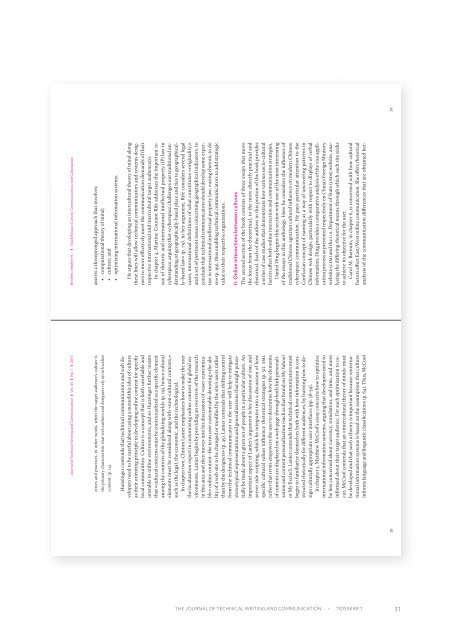Bachelor – Mediedesign NTNU Gjøvik
Min bachelor i mediedesign ved NTNU Gjøvik.
Min bachelor i mediedesign ved NTNU Gjøvik.
You also want an ePaper? Increase the reach of your titles
YUMPU automatically turns print PDFs into web optimized ePapers that Google loves.
28<br />
Journal of Technical Writing and Communication Vol. 45 No. 1 2015<br />
ctives and practices, in other words, when the target audience’s culture is<br />
the primary characteristic that web authors and designers rely on to localize<br />
content. (p. 14).<br />
Hunsinger contends that technical communicators and web developers<br />
need to be careful about using a monolithic idea of culture<br />
as their orienting principle in developing online content for specific<br />
local communities. Culture is a concept that is both unreliable and<br />
unstable in online environments, and so Hunsinger further insists<br />
that «cultural concerns must be contextualized as a specific element<br />
among the contexts of the globalizing world» (p. 19), hence cultural<br />
elements must be considered along with «non-cultural contexts,»<br />
such as the legal, the economic, and the technological.<br />
In chapter two, Clinton Lanier emphasizes how to make the user<br />
the localization expert in customizing online content for global environments.<br />
Lanier begins by providing an overview of the research<br />
in this area and then moves into his discussion of «user-customizable»<br />
online content<strong>–</strong>the term user customizable denoting «the ability<br />
of a web site to be changed or modified by the site’s users rather<br />
than by the designers» (p. 45). Lanier contends that shifting control<br />
from the technical communicator to the user will help to mitigate<br />
stereotypical representations and generalizations that might potentially<br />
be made about a given set of people in a particular culture. An<br />
important aspect of Lanier’s argument is his discussion of xml and<br />
server side scripting, which he integrates into a discussion of how<br />
specific cultural values influence rhetorical strategies (p. 51). xml<br />
rather that html empowers the user to determine how the elements<br />
of content are displayed on a web page through both link personalization<br />
and content personalization (such as that found on My Yahoo!<br />
or My Excite!). Lanier contends that technical communicators must<br />
begin to familiarize themselves both with how information is constructed<br />
rhetorically for different audiences, by learning how to design<br />
culturally appropriate user interfaces (pp. 58-59).<br />
In chapter 3, Matthew McCool’s essay concerns how to optimize<br />
international information systems, arguing that developers need to<br />
be less concerned about currency, translation, and time, and more<br />
informed about their target audience. For such optimization to occur,<br />
McCool contends that an «intercultural theory of mind« must<br />
be developed and that such a theory is important because «international<br />
information systems is based on the assumption that culture<br />
informs language and linguistic classification» (p. 64). Thus, McCool<br />
Brasher, Stephen H. Book Review: Culture, Communication, and Cyberspace<br />
asserts a threepronged approach that involves:<br />
• computational theory of mind;<br />
• culture; and<br />
• optimizing international information systems.<br />
He argues that developing an intercultural theory of mind along<br />
these lines will allow technical communicators and systems designers<br />
to more effectively meet the communication demands of their<br />
respective international and intercultural target audience(s).<br />
In chapter 4, Martine Courant Rife addresses the important issue<br />
of rhetoric and international intellectual property (IP) law in<br />
cyberspace, arguing that «cyberspace challenges our traditional understanding<br />
of geographically-based place and ties to geographically-based<br />
law» (p. 79). In her argument, Rife considers several legal<br />
cases, international definitions of what constitutes «originality,»<br />
and a set of pertinent issues concerning geographical indicators, to<br />
conclude that technical communicators should develop some expertise<br />
in international intellectual property law, «using rhetoric to do<br />
so» (p. 99), thus enabling technical communicators to add strategic<br />
value to their respective organizations.<br />
II. Online interactions between cultures<br />
The second section of the book consists of three essays that move<br />
the focus from the theoretical, to the more directly practical and<br />
rhetorical. Each of the authors in this portion of the book provides<br />
a series of case studies that demonstrate how various socio-cultural<br />
factors affect both online interaction and communication strategies.<br />
Daniel Ding begins this section with one of the most interesting<br />
of the essays in this anthology. Here he considers the influence of<br />
traditional Chinese agrarian cultural influence on modern Chinese<br />
cyberspace communication. He pays particular attention to the<br />
Confucian concept of naming as a way of uncovering patterns in<br />
Chinese web design, particularly with respect to displays of verbal<br />
information. Ding provides a comparative analysis of the visa application<br />
process as presented respectively on China’s Foreign Ministry<br />
website (cfm) and the u.s. Department of State (usds) website, analyzing<br />
the differing rhetorical means through which each site seeks<br />
to achieve its objective for the user.<br />
Carol M. Barnum, in chapter 6, is concerned with how cultural<br />
factors affect East/West online communication. She offers rhetorical<br />
analysis of the communication differences that are obtained bet-<br />
29<br />
THE JOURNAL OF TECHNICAL WRITING AND COMMUNICATION TIDSSKRIFT<br />
31


